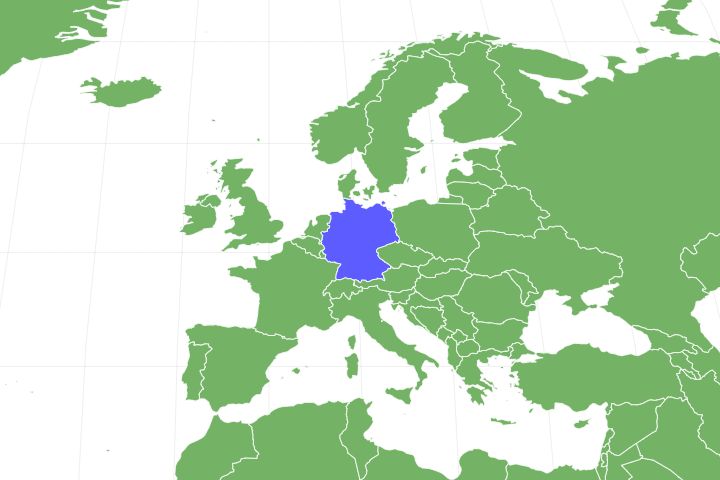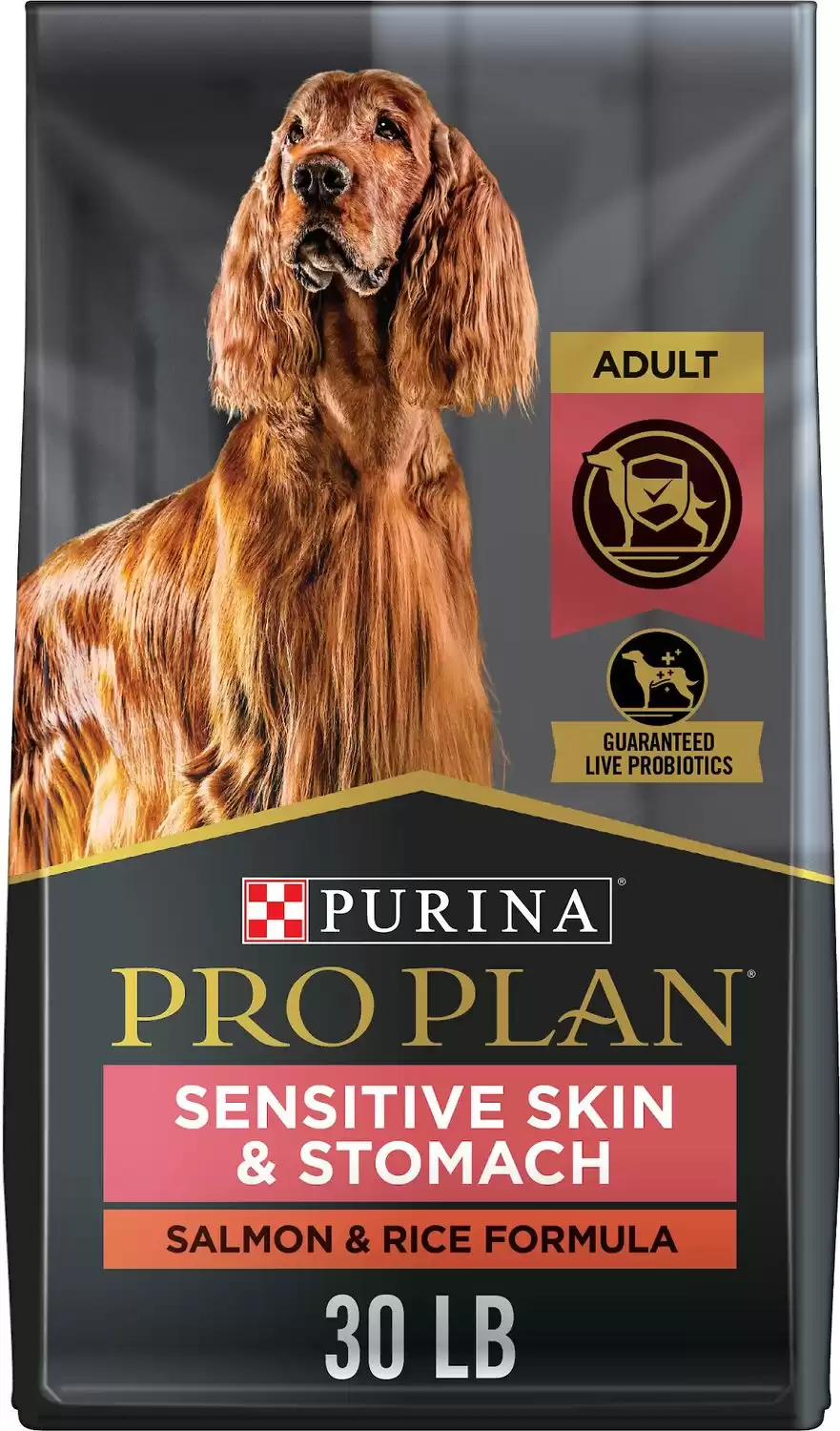German Spitz
Canis lupus
There are five different sub-breeds of the German Spitz.
Advertisement
German Spitz Scientific Classification
- Kingdom
- Animalia
- Phylum
- Chordata
- Class
- Mammalia
- Order
- Carnivora
- Family
- Canidae
- Genus
- Canis
- Scientific Name
- Canis lupus
Read our Complete Guide to Classification of Animals.
German Spitz Conservation Status
German Spitz Facts
- Fun Fact
- There are five different sub-breeds of the German Spitz.
- Temperament
- Lively, devoted to family, intelligent, and beautiful
- Diet
- Omnivore
German Spitz as a Pet:
- General Health
- Energy Level
- Shedability
- Trainability
- Intelligence
- Tendency to Chew
- Size
- Family and kid friendliness
- Yappiness / Barking
- High
- Separation Anxiety
- High
- Preferred Temperature
- Cold climate
- Exercise Needs
- High
- Friendly With Other Dogs
- Moderate
- Pure bred cost to own
- $400-$700 for a puppy, less for an adult.
- Dog group
- Non-sporting
- Male weight
- 23-25 lbs
- Female weight
- 23-25 lbs
This post may contain affiliate links to our partners like Chewy, Amazon, and others. Purchasing through these helps us further the A-Z Animals mission to educate about the world's species.
View all of the German Spitz images!
Though they are believed to be bred from hunting and herding dog, the German Spitz is mostly a small companion breed nowadays.
Forever loving and happy to see its owner, the German Spitz has all of the dense and thick fur that anyone could want. Available in several different colors, the German Spitz will act as the most stoic watchdog as he barks at any living thing that passes by your home. Not bred for hunting, this dog is still extremely rare and is not yet recognized officially by the AKC as a purebred pup.
See all of our expert product reviews.
German Spitz vs. Pomeranian
The German Spitz and the Pomeranian are both part of the Spitz family, though the Pomeranian is significantly more popular. Both are purebred dogs, but the Pomeranian is just one-fifth of the average size German Spitz. Plus, the German Spitz is twice the average height of the Pomeranian.
German Spitz vs. Japanese Spitz
The German Spitz and the Japanese Spitz are much more similar to each other than the German Spitz and the Pomeranian, though there are a few differences. While the German Spitz can have white, orange, black, or even tricolor fur, the Japanese Spitz is only bred as a white dog. Both require a lot of grooming and shed often.
The 5 Different Types of German Spitzes and German Spitz Mixes
The German Spitz is a beautiful dog, but it is only a category of five different varieties. The personality amongst these dogs is rather similar, offering a loving temperament that can barely stand to part with their owners. The main differences are found in their size and color.
The five types include:
- Wolfsspitz (or Keeshond).
- Giant Spitz (or Großspitz).
- Medium Spitz (or Mittelspitz or Mittel Spitz).
- Miniature Spitz (or Kleinspitz).
- Pomeranian or Zwergspitz (“Dwarf Spitz”).
The Wolfsspitz (or Keeshond) has a grey coat and can weigh up to 66 lbs.
Health and Entertainment for your German Spitz
See all of our expert product reviews.
The Giant Spitz (or Großspitz) has a white, black, or brown coat, and it often has white areas across the paws, along the chest, and on the end of their tail. They weigh up to 40 lbs.
The Medium Spitz (or Mittelspitz or Mittel Spitz) comes in many colors, including orange or white. They only weigh up to 25 lbs.
The Miniature Spitz (or Kleinspitz) is found in similar colors, but only weighs 22 lbs. when fully grown.
The Pomeranian (or Zwergspitz, which means “Dwarf Spitz”) is the smallest at just 6.6 lbs. as an adult. It also comes in many colors.
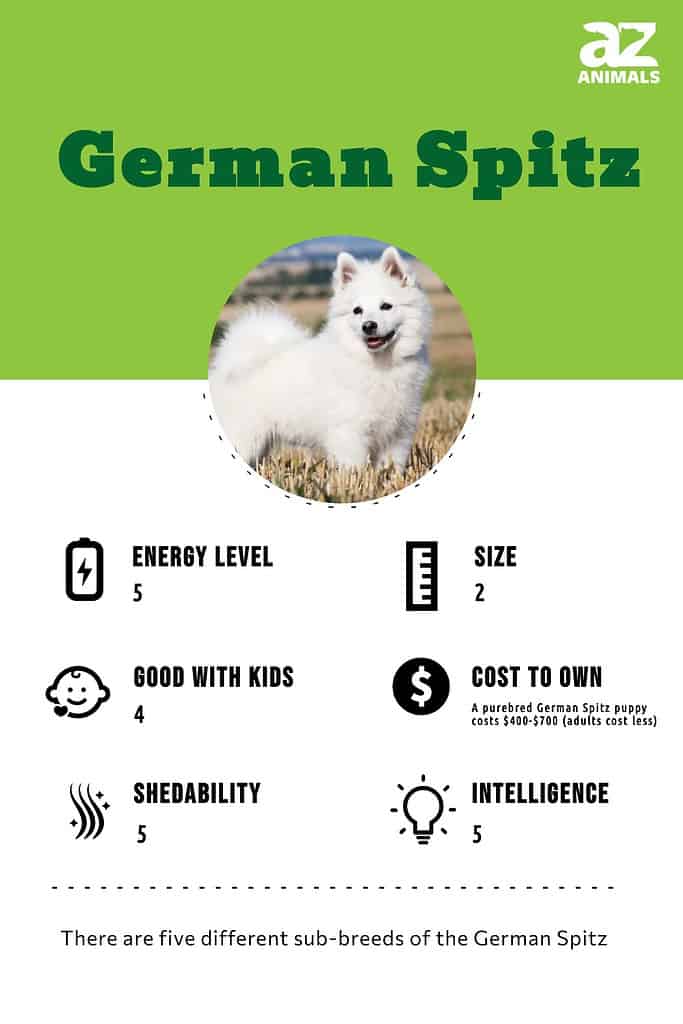
3 Pros and Cons of Owning a German Spitz
Here are a few of the benefits and challenges of introducing a German Spitz to the home.
| Pros! | Cons! |
|---|---|
| Incredibly intelligent: This dog’s intelligence makes it easy to train and prepare for the world around it. | Sheds constantly: The massive coat of the German Spitz needs to be maintained, but any brushing will likely leave tons of fur in the air around you. |
| Loving: The German Spitz loves to dote on its family members, though it may be a bit of a challenge with younger and inexperienced children. | Very vocal. As strong as this dog may be as a watchdog, individuals in small communities may not appreciate the constant barking of this breed. |
| Soft: There are very few dogs that feel this good to cuddle up with, giving a thick pillow of undercoat to pet. | Bossy. Though it is easy to train this dog, the German Spitz can have a mind of his own. |
Size and Weight
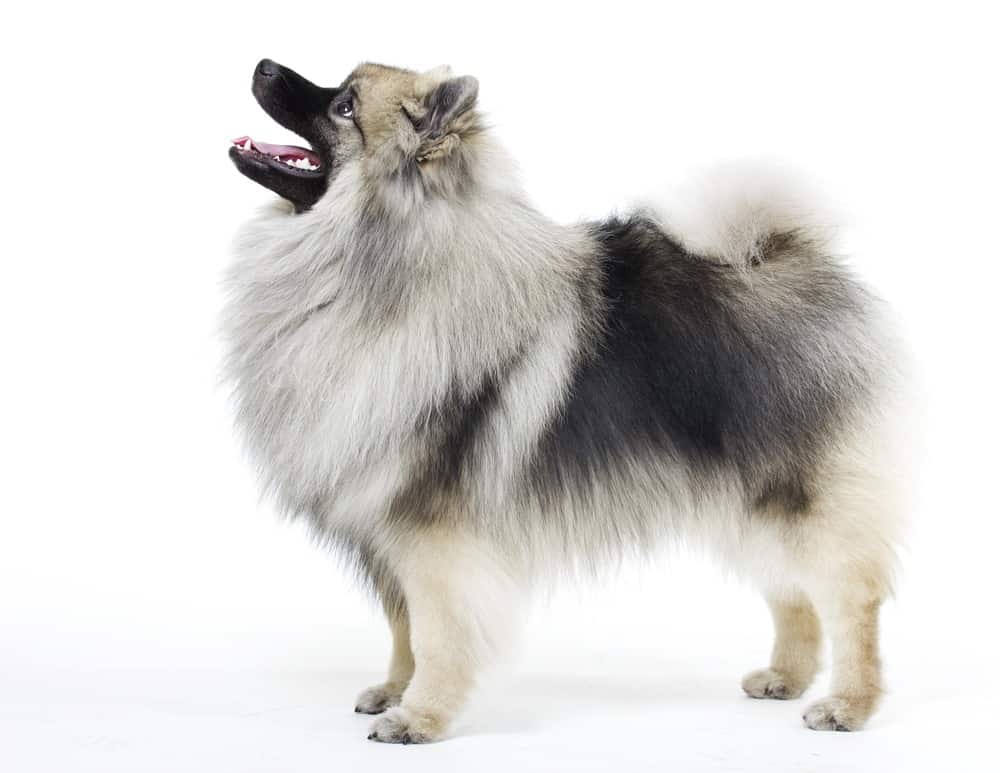
The heaviest variety of German Spitz is capable of weighing 66 lbs while the smallest may weigh 3.1 lbs
©Serova_Ekaterina/Shutterstock.com
The size of the German Spitz will largely depend on the variety that you choose. The Wolfsspitz, which is also called the Keeshond, can weigh between 55 and 66 lbs., giving it a medium build at 17-22 inches tall. The Giant spitz (also known as the Großspitz), is also a medium size, weighing up to 40 lbs. and standing at 17-22 inches tall as well. The Medium Spitz (also known as the Mittelspitz or the Mittel Spitz) is the last of the medium-sized variations, weighing significantly less at 23 to 25 lbs. and standing at 12-16 inches tall.
There are also two smaller variations, distinct in their petite size. The miniature spitz (or the Kleinspitz) weighs 18-22 lbs. and stands at 9.4-11.8 inches tall. Finally, the Pomeranian (also known as Zwergspitz) is a dwarf-sized pup, standing at just 7.1-9.4 inches tall and weighing only 3.1-6.6 lbs.
| Height (Male) | Up to 22 inches tall |
| Height (Female) | Up to 22 inches tall |
| Weight (male) | Up to 66 lbs., fully grown |
| Weight (female) | Up to 66 lbs., fully grown |
Origins
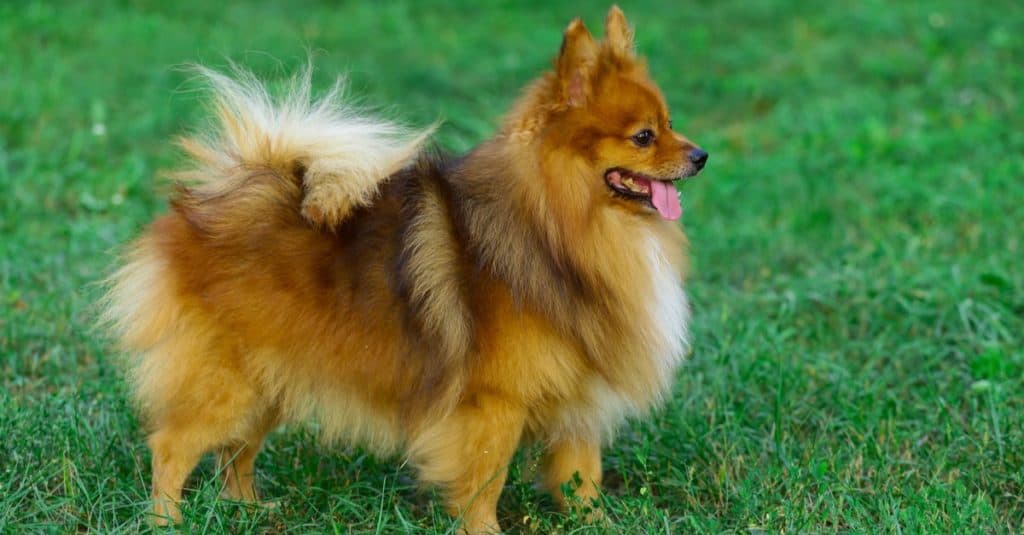
German Spitz were once a popular fixture at the English royal court
©BidaOleksandr/Shutterstock.com
The story of the German Spitz is believed to have begun in a province once located on the southern Baltic, between Germany and Poland known as Pomerania. As a matter of fact, it is from this region the Pomeranian or Toy Spitz (the breed’s smallest incarnation), draws its name.
Once working dogs, these domestic canines were charged with guarding the wares of traders, farmers, and fishermen, typically from a high perch from which they could spot approaching pilferers.
The earliest written reference to the breed dates back to the mid-fifteenth century when a German noble praised its defensive capabilities. German Spitz soon became acquainted with royalty by the 1700s at the court of King George I of England. His wife was German and as a result, the royal couple received large numbers of German visitors, some of whom came with those fluffy canines in tow.
However, by the early part of the twentieth century, the fortunes of the breed declined during the years following the First World War. Thankfully, they experienced a spectacular reversal about half a century later thanks to breeding efforts involving larger Pomeranians and Dutch Keeshonds.
Common Health Issues
You might be happy to learn that the German Spitz is an incredibly healthy and active dog, which is part of the reason that it has few health issues to worry about. However, they are at a greater risk of dental issues, which can be corrected with regular brushing and cleaning.
A luxating patella is often common with this dog, which means that the joint comes out of place at the knees. It is evident that this problem has occurred when the pup starts to limp. Sometimes, progressive retinal atrophy can occur, leading to blindness.
Ultimately, the health issues to watch out for include:
- Dental Problems
- Luxating Patella
- Progressive retinal atrophy (PRA)
Temperament
The personality of the German Spitz makes this dog a rather appealing animal to many families. When it is at its best, this dog is incredibly attentive and lively, which is part of the reason that he can become incredibly defensive of his owners. While this dog will likely enjoy the mundane nature of lounging around with a loved one, he also craves physical activity, engaging in playful games with others in the home.
He is the ideal watchdog, frequently alerting anyone nearby that a stranger is coming to the door or home. This vocal nature is one of the many traits that makes this dog ideal for a home without a lot of outside activity, or he might become anxious at the inability to “defend” the home. Still, a little training goes a long way, even if the German Spitz still wants to express every thought and feeling with vigor.
Considering his ever-excited behavior, the German Spitz seems to have no concern with the outside weather, making him a fun companion for outdoor activities. Overall, these dogs are vocal dogs, and it is bred to be the ultimate watchdog.
How to Take Care of the German Spitz
Bringing home any new pet can be overwhelming, but the German spitz requires a certain amount of care to thrive within the home. Consider these tips below as you prepare your home.
The Best Dog Food for the German Spitz
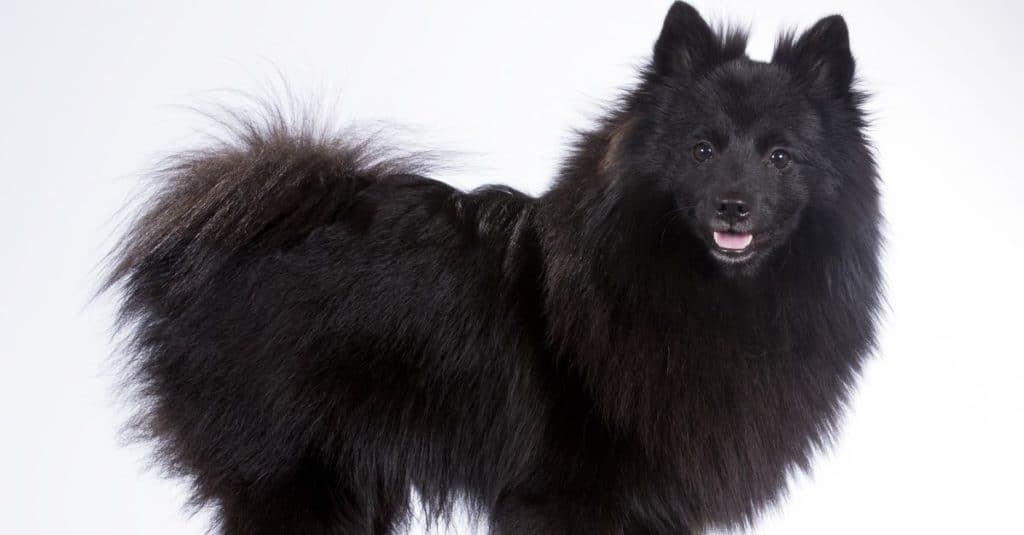
German Spitz require food of excellent-quality in order to be able to enjoy optimum health
©Jne Valokuvaus/Shutterstock.com
While any dog requires a bit of indulgence, these dogs must have extremely high-quality dog food to keep it healthy. Without dry dog food and consistent access to water, plaque can form on the teeth and cause incredible infections.
For a dry dog food that keeps the German Spitz’s teeth clean and shiny, A-Z Animals can point you to Purina Pro Plan Sensitive Skin & Stomach, High Protein Adult Dry Dog Food for all breed sizes.
The calcium supports dental health, and combined with glucosamine, aids in the good formation of cartilage to help prevent patellar luxation. The taurine and vitamin A can help keep your German Spitz’s eyes bright and working well.
Purina Pro Plan Sensitive Skin and Stomach High Protein Dog Food is available on Chewy or Amazon.
- Salmon and rice recipe for sensitive stomachs and and skin
- Live probiotics for optimum digestive health
- Sunflower oil promotes healthy skin and coat
Maintenance and Grooming

German Spitz are shed heavily and as a result require extensive grooming compared to several other canines
©ElenaYakimova/Shutterstock.com
These dogs require a little more grooming than other dogs. They shed seasonally, and weekly brushing is required to keep them healthy and their coat shiny. If the dog has a lot of buildup of extra fur, giving them a nourishing bath and blow-drying their coat can help to eliminate the excess.
Always make sure to trim this dog’s nails and take a look at their ears to keep them clean as well.
Training
Part of the reason that so many people enjoy the demeanor of these dogs, is because their intelligence makes the breed rather easy to train. These pups are eager to please their owners, responding positively when there is a motive. However, one of the unique traits of the species is that they tend to bark, becoming very vocal as they learn to respond to new commands.
Still, as obedience training and new tricks are learned, it is easy to get the German Spitz to follow along.
Exercise
As small as this dog breed is, these dogs require a lot of physical activity. Bringing them outside or taking them for a long walk will help them to get out some of the natural energy they often possess. They are incredibly easy to train to keep on the leash, though you might notice a little barking as strangers walk by, allowing them to fulfill their desire to be your watchdog.
Puppies
A puppy requires about the same amount of care as the adult version. They will need regular grooming weekly to eliminate the risk of matting and knots, and they will need incredibly high-quality dog food to maintain their small build. Make a habit of providing appropriate dental care early in life to keep them from developing the dental problems that the species is known for.

©Ivan4es/Shutterstock.com
Children
The loving and patient nature of these dogs makes them wonderful companions with young children. Within the entire family, this type of dog is incredibly loving and doting, adoring any moment that they can spend in play or being petted. As far as young children, they are moderately good, provided that the child is properly told how to interact with a pet.
Like any other breed, these dogs should not be left unsupervised with children that don’t have much exposure to these types of pets to prevent unfortunate accidents from occurring. Older children will likely have a much easier time playing and bonding.
Dogs similar to German Spitz
If a German Spitz isn’t a good match, try out one of these breeds:
- Akita – With a similar size and a courageous heart, the Akita is a great compromise.
- American Eskimo Dog – This pup is fairly similar in lifespan, and it is perfect for colder climates.
- Shiba Inu – Friendly and playful, the Shiba Inu has a relatively vocal personality like the German Spitz.
Famous German Spitz
Most of the time, whether in film or television, the German Spitz has not been made a prominent dog breed quite yet. However, the smallest of this dog group – the Pomeranian – has frequently been featured in the media. Most famously, celebrities like Kate Hudson, Liza Minelli, and Cindy Williams have all made this miniature puppy their own.
Popular Names for German Spitz
Some of the common names for the these dogs include:
- Moe
- Ginger
- Donnie
- Queen
- Hudson
German Spitz FAQs (Frequently Asked Questions)
How much does a German Spitz cost?
To buy a purebred German Spitz puppy, the total price typically ranges from $400 to $3,000, depending on the breeder. This species is still rather rare to certain areas of the world, and breeders will price their animals with the understanding of how rare the animal is. Adults have a lower price, though browsing pet shelters will likely result in a lower price tag.
Are German Spitz good pets?
Absolutely. This type of dog thrives in a home with many loving family members, though they prefer to be the boss when they can be.
Do German Spitz shed a lot?
Yes. The German Spitz has a double coat, and frequent brushing will result in substantial shedding.
Is a German Spitz a Pomeranian?
Not exactly. A Pomeranian is considered to be a subtype of the Spitz family, and it is the smallest variation of the Spitz.
How much are German spitz puppies?
A German Spitz puppy costs approximately $400 to $700, though some breeders will price them as high as $3,000.
Is the German Spitz good with kids?
For the most part, yes. However, children that have not been properly taught the correct behaviors in handling and engaging with smaller dogs may need constant supervision.
How long does the German Spitz live?
Due to the incredible health of the German Spitz, this breed tends to live a long and healthy life, reaching an average of 13-15 years. However, the variation of the spitz (based on size and subtype) could live even longer.
Thank you for reading! Have some feedback for us? Contact the AZ Animals editorial team.
Sources
- German Spitz Love, Available here: https://germanspitzlove.com/german-spitz-hot-cold-weather/
- American Kennel Club, Available here: https://www.akc.org/dog-breeds/german-spitz/
- Vetstreet, Available here: http://www.vetstreet.com/dogs/german-spitz
- Dogtime, Available here: https://dogtime.com/dog-breeds/german-spitz
- Perfect Dog Breeds, Available here: https://www.perfectdogbreeds.com/german-spitz/
- Dogell, Available here: https://dogell.com/en/compare-dog-breeds/german-spitz-vs-pomeranian

